 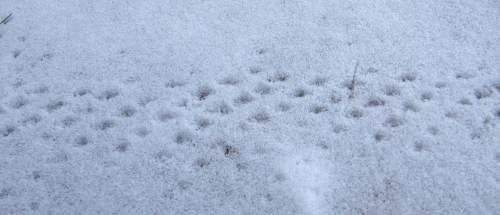 I find a lot of animal tracks around our suburban house, and they are particularly visible after a light snow. But in late January, 2010, I was startled to find the tracks pictured above. The picture doesn't give a good indication of the scale, but the indentations in the snow are about 1 cm apart. What on earth could possibly have made that? A parade formation of oversized centipedes? See if you can guess what did it. Hint: it's not any sort of tire - it's an entirely natural phenomenon. I'll reveal the answer at the end of this entry.
Indeed, we're quite familiar with our local turkeys. Large groups of turkeys like this are a fixture in our neighborhood, in part because several of our neighbors feed them. Another neighbor wasn't thrilled by this, however, especially when a turkey pecked dents into his car door. This was the result of an effort by a tom turkey to discourage what he perceived as a rival male, actually his own reflection in the shiny door finish. I've already written a bit about these local turkeys, and where they came from, at the end of my previous blog entry, "The house of turkey death". The photo below shows a group of them congregating on our neighbor's lawn:  In the photo above, note that the turkeys are being observed warily by our neighbor's cat "Pandora", who's sitting on the stoop at the upper-right. She wouldn't dare attack the turkeys, who not only substantially outweigh her, but who also have sharp spikes on the backs of their feet.
I recalled an occasion in which I saw an even larger stag in somebody's backyard. Margie and I were visiting my uncle Bill, who had a house in the town of Tannersville, New York, high in the Catskill Mountains. We were calling on a neighbor of Bill's, when we saw an enormous stag standing in his backyard, only a few meters from the house. We all looked at it silently for a while, admiring it. At least I thought we were all admiring it, until the neighbor spoke, saying, "You never have your rifle when you really need it." Although we enjoy seeing deer in our backyard, they have voracious appetites, which can be quite a nuisance. We've stopped feeding the birds, because the deer push the bird feeder with their nose, shaking it and spilling the seed to the ground. This is to allow them to eat the seed, which they otherwise can't reach inside the bird feeder. They also eat a lot of our ornamental perennials. They're particularly fond of hosta, which they often munch right down to the ground. They can be repelled by cougar piss and other such repellents that can be purchased at our local nursery, but I often forget to apply these concoctions until too late. This year, as last year, they stripped all the flowers and leaves from most of our hydrangeas.
Animal tracks are always interesting. Although I sadly have no photograph of this event, I once found a track which showed the capture of some small rodent by a raptor. The tracks of the rodent, perhaps a rat or a vole, came across the snow. There then was an area of snow which had been considerably disturbed, with wing tip feather markings around the periphery. At that point, the rodent track ended. The animal had clearly been carried off.
I had never seen anything like this happen before, and it took just the right conditions to allow it to take place. The snow cover had to be just a dusting, because if the snow had been any deeper, pinecones already on the ground would have been covered. Alternatively, pinecones that fell to the ground after the snow had already fallen would have sunk in under their own weight, and would not have been able to roll. The pinecones had to fall on the flat driveway, where they could roll easily, rather than on a lawn or irregular ground. And the wind had to be strong enough to roll the cones, but not so strong as to blow them away. Curious, but not quite so bizarre as a parade of giant centipedes. January, 2013 update: another entry about tracks in the snow was added, called Life in the 'burbs.
  |
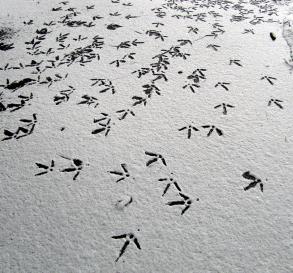 The tracks I found in the snow about a year later were a lot more obvious. Again, to give you an idea of the scale, those middle toes could be 5 to 7 cm long (2 to almost 3 inches). Only a wild turkey can leave a footprint like that, and obviously quite a group of them had congregated in the driveway.
The tracks I found in the snow about a year later were a lot more obvious. Again, to give you an idea of the scale, those middle toes could be 5 to 7 cm long (2 to almost 3 inches). Only a wild turkey can leave a footprint like that, and obviously quite a group of them had congregated in the driveway.
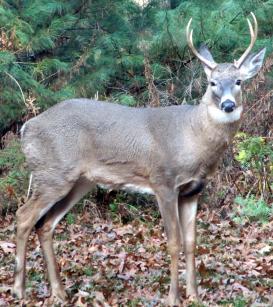 We also have many deer in our neighborhood. The picture to the right shows a stag I photographed on our lawn in November of 2009.
We also have many deer in our neighborhood. The picture to the right shows a stag I photographed on our lawn in November of 2009.
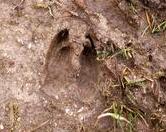 When Margie and I visited a friend who owns an island in Lake Winnipesaukee, she complained that someone had cut some of her flowers. I looked at the plant in question, and noted that if I didn't know any better, I would have thought that they had been munched by a deer. However, I thought that since we were on an island, deer were out of the question. Until, in a muddy area near the plant, I found an unmistakable deer footprint, like the one shown to the left. This prompted me to walk around the island, which has an area of about 12,000 square meters (about 3 acres).
When Margie and I visited a friend who owns an island in Lake Winnipesaukee, she complained that someone had cut some of her flowers. I looked at the plant in question, and noted that if I didn't know any better, I would have thought that they had been munched by a deer. However, I thought that since we were on an island, deer were out of the question. Until, in a muddy area near the plant, I found an unmistakable deer footprint, like the one shown to the left. This prompted me to walk around the island, which has an area of about 12,000 square meters (about 3 acres).
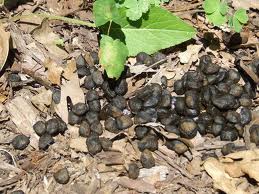 In my inspection, I found deer footprints all over the place. Even more interesting, I found many samples of deer "scat", which is to say feces, like those shown to the right. That was more interesting because it's easier to tell the age of a scat sample than it is to tell the age of a footprint. Some of the scat was quite fresh, while other samples were dried out. What I didn't see were any actual deer. So it became clear that the deer have no trouble swimming from the mainland to the island, which is less than 200 meters (about 650 feet) from the shore at its closest point.
In my inspection, I found deer footprints all over the place. Even more interesting, I found many samples of deer "scat", which is to say feces, like those shown to the right. That was more interesting because it's easier to tell the age of a scat sample than it is to tell the age of a footprint. Some of the scat was quite fresh, while other samples were dried out. What I didn't see were any actual deer. So it became clear that the deer have no trouble swimming from the mainland to the island, which is less than 200 meters (about 650 feet) from the shore at its closest point.
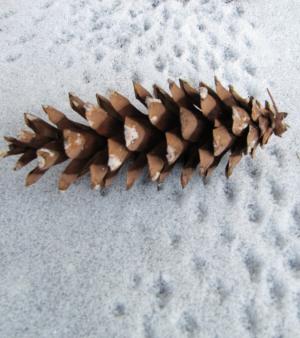 Okay, time to solve the mystery posed at the beginning of this entry. I had to look around a bit to find out what had produced the mysterious tracks. And what I saw is shown in the picture to the left. The "tracks" were being made by pine cones, which were being blown by the wind, causing them to roll across the light snow.
Okay, time to solve the mystery posed at the beginning of this entry. I had to look around a bit to find out what had produced the mysterious tracks. And what I saw is shown in the picture to the left. The "tracks" were being made by pine cones, which were being blown by the wind, causing them to roll across the light snow.